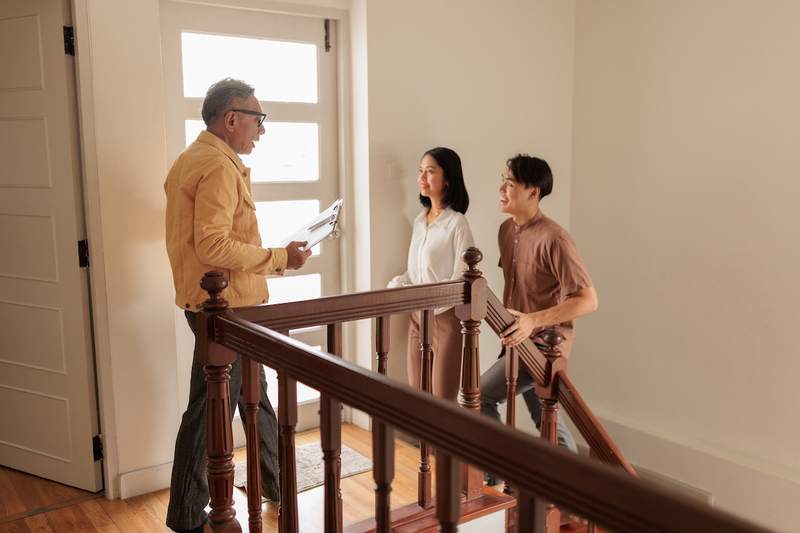As you approach closing day, the final walk-through gives you one last chance to inspect the home before it’s yours. In most cases, the walk-through is a formality. But sometimes, last-minute problems crop up that you’ll need to resolve quickly with the seller to close on schedule.
Key Takeaways:
- While it’s rare, you want to look for common problems with the home you’re buying on the final walk-through.
- For example, items may be left behind, the seller may not have completed all the agreed-upon repairs, or you might find new damage or evidence of pests.
- You can work with the seller to resolve the problem, delay the closing date, or cancel the sale if failing to resolve it is a deal breaker.
Common Final Walk-Through Problems
Let’s take a look at some common problems that may come up during your final walk-through.
Belongings are left behind
You might find the seller left behind some items when they moved out. Maybe they didn’t want or need them, but it’s not your job to take out the seller’s trash.
Missing items
If you and the seller agreed to include the washer, dryer, refrigerator, or other appliances or furniture in the sale, make sure they haven’t been removed.
New damage
Sometimes, moving out furniture or other large items damages the walls or floors. Also, seeing the home without the seller’s belongings in it may reveal damage you hadn’t seen before. The walk-through is a chance to make sure the home is in the condition you expect before you buy it.
“The property may have suffered new damages since the last inspection, such as broken fixtures, holes in walls, or damaged flooring,” says Chris McGuire, a real estate investor and founder of Real Estate Exam Ninja in Birmingham, Alabama. “It’s important to thoroughly document any new issues during the final walk-through.”
It needs cleaning
Home purchase agreements typically require that the home be “broom swept” by closing day. While the house doesn’t need to be deep cleaned, it does need to be swept and vacuumed at the minimum.
Agreed-upon repairs not made
If the seller agreed to repair the home before closing, this is your chance to make sure they’ve been completed. Bring any paperwork documenting what the seller agreed to fix so you can verify whether the work’s been done.
Appliances aren’t working
Check that all the appliances included in the sale are working correctly. Imagine spending the day moving in only to find that the fridge is broken and you can’t keep any food until you get it fixed or buy a new one.
Utilities shut off
For a home to be habitable, it needs running water and electricity. Make sure to test the lights, outlets, and faucets to make sure everything is working correctly.
HVAC problems
It can be difficult and expensive to control the temperature in older homes. Make sure the heating, ventilation, and air-conditioning systems are functioning correctly.
Leaks or mold
Mold can pose various health risks, including upper respiratory tract symptoms, coughing, wheezing, fever, and shortness of breath. Depending on the extent of the problem, mold and water damage also can be expensive to remove or fix.
Plumbing problems
Flush the toilets and run the faucets to test the plumbing and verify the drains are not clogged.
Faulty windows or doors
The windows and doors in the home should open, close, and lock correctly. If the exterior doors don’t lock, it poses a significant security threat. If windows can’t be securely closed, it could pose a safety risk or drive up heating and cooling bills.
Evidence of pests
If you find evidence of rodents, termites, or roaches during the final walk-through that weren’t detected during the home inspection, consider yourself lucky. That’s what the final walk-through is for: To catch issues you can address with the seller before you close on the home.
Irrigation system failure
If your home has a lawn, garden, or other vegetation watered via sprinklers or an irrigation system, you’ll want to run them to make sure they’re working correctly.
Poorly maintained landscaping
Speaking of the lawn and landscaping, you’ll want to make sure lawns, trees, and plants have been watered and trimmed. If a garden, rocks, or certain trees were part of the deal, make sure the seller hasn’t dug them up or removed them.
How To Resolve Final Walk-Through Problems
If you find problems during the final walk-through, you’ll need to address them with the seller before closing.
“To resolve walk-through problems effectively, communication and documentation are key,” McGuire says. “If problems are identified during the final walk-through, it’s essential to communicate the concerns with the seller or their representative. Provide them with a detailed list of the issues and request resolution.”
Work with your agent
Your real estate agent typically accompanies you on the final walk-through, while the seller and their agent usually are absent. An experienced agent can advise you on the best way to proceed and handle discussions and negotiations with the seller.
Negotiate with the seller
Once you and your agent have communicated your concerns to the seller, you can try to negotiate a solution. For some issues, it may be as simple as the seller removing or putting back items that should or shouldn’t be there. If you’ve found damage or specific systems aren’t working correctly, you can ask the seller to make or pay for repairs.
“Depending on the nature and extent of the problems, you may negotiate with the seller to have the necessary repairs completed before closing or to receive compensation or credits to cover the cost of addressing the issues yourself,” McGuire says.
Delay closing
If the seller agrees to make repairs but needs more time, you can mutually agree to delay closing. Though pushing back your closing and move-in dates may be frustrating, it’s likely better than moving into a home with preexisting problems.
Hold back escrow funds
What happens if repairs are needed but the seller is unwilling to address them? One option is to withhold a portion of the seller’s proceeds in escrow to cover those costs. This would allow you to close the deal as planned and use the escrow funds to pay for repairs.
“In some cases, if repairs or remedies cannot be completed before closing, you can negotiate to have funds held in escrow to cover the cost of addressing the outstanding issues after the closing,” McGuire says. “This allows you to move forward with the transaction while ensuring that the necessary repairs or resolutions are still addressed.”
Renegotiate the sale
If the seller is unwilling to make repairs, you could try to negotiate the sale price to reduce it by the amount needed to pay for repairs. That way, the seller doesn’t have to fix anything, and you get a better deal on a home with a defect.
Cancel the sale
You and the seller have already gotten this far, and it’s unlikely that either party wants the deal to fall through over something fixable. However, if the issue is serious enough and the seller won’t budge, you may want to back out of the deal entirely. Doing so requires you to have an appropriate contingency in the purchase and sale agreement.
“While many walk-through problems can be resolved through communication, negotiation, and proper documentation, there may be instances where certain issues cannot be effectively resolved,” McGuire says. “For example, if there are undisclosed structural issues, significant code violations, or environmental hazards that were not previously disclosed, it may be challenging to resolve these problems satisfactorily. In such cases, it’s important to consult with legal professionals and explore your options for potential recourse or cancellation of the transaction to protect your interests as a real estate investor.”
Consider legal action
In rare cases, the final walk-through may reveal that the seller has failed to complete agreed-upon repairs or the repair work that has been done is insufficient. If you can’t come to a resolution, then it may be necessary to take legal action. It’s best to consult an experienced real estate attorney to determine the right course of action.
FAQ: How To Resolve Problems on the Final Walk-Through
Here are answers to some frequently asked questions about resolving problems with the final walk-through
Yes. “If significant issues are discovered during the final walk-through that were not previously disclosed or addressed, you may be able to negotiate with the seller for additional repairs, credits, or compensation,” McGuire says. “However, the extent of negotiation after the final walk-through may depend on the terms of the purchase agreement and the willingness of both parties to come to a resolution.”
Home purchase and sale agreements often allow a short extension to the closing date if certain repairs need to be completed. If you push your closing date beyond one month, you may have to pay a fee for every day of delay.
No. The seller can’t refuse a final walk-through if it’s included in the purchase and sale agreement.
The Bottom Line on How To Fix Problems With The Final Walk-Through
Many real estate transactions go smoothly, and any issues detected during the home inspection are resolved by the time the buyer does their final walk-through. However, if the final walk-through reveals problems, you have several options for resolving them. You can set yourself up for success by being as thorough as possible with your final walk-through and working with your agent and the seller to resolve any problems before closing.
More From LowerMyBills:
- Final Walk-Through Checklist for Homebuyers
- The Ultimate Home Inspection Checklist for Buyers
- How Long Does the Home Inspection Take?
- What To Look For on a House Tour
- What Does It Mean To Buy a House ‘As Is’?
- How To Avoid Homebuyer’s Remorse
- Buying a Fixer-Upper: What You Need To Know






